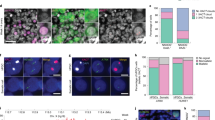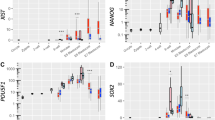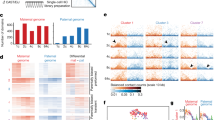Abstract
THE mechanism by which one X chromosome in normal cells of female mammals becomes inactive while the other, apparently identical, chromosome remains active is not known. In kangaroos the paternally derived X chromosome is preferentially inactivated in most tissues1, and in mice and rats similar preferential inactivation of the paternal X chromosome occurs in the cells of the extraembryonic membranes2,3. Paternal X inactivation in kangaroos led Cooper4 to postulate that passage of the X chromosome through male gametogenesis was an important factor in its inactivation. He4 and Brown and Chandra5 suggested that paternal X inactivation was a primitive form and that random X inactivation as seen in adult eutherian mammals had evolved from it. Brown and Chandra further suggested that passage of one chromosome set through male gametogenesis or fertilisation led to chromosomal imprinting. A locus concerned in the control of X chromosome activity was postulated to become inactive when imprinted, and one active copy of this gene could maintain the activity of one X chromosome. In marsupials this gene was postulated to lie on the X chromosome itself, but on an autosome in euitherians. Thus, in eutherians the number of active X chromosomes in any animal should be equal to the number of maternally derived (and therefore non-imprinted) autosome sets. In this context it is interesting to study X inactivation in artificially formed parthenogenetic embryos, in which all chromosomes are of maternal origin. We report here that diploid parthenogenetic mouse embryos, at the late egg cylinder stage, showed a single late replicating chromosome, indicating that X inactivation had occurred normally. Because in the production of these embryos polar body formation had been suppressed, it seems that neither passage of chromosomes through male gametogenesis, nor fertilisation, nor probably the effects of peripheral egg cytoplasm are required for normal X inactivation in the mouse.
This is a preview of subscription content, access via your institution
Access options
Subscribe to this journal
Receive 51 print issues and online access
$199.00 per year
only $3.90 per issue
Buy this article
- Purchase on Springer Link
- Instant access to full article PDF
Prices may be subject to local taxes which are calculated during checkout
Similar content being viewed by others
References
Cooper, D. W. et al. in Isozymes III: Developmental Biology (ed. Market, L. C. ) 559 (Academic, New York, 1975).
Takagi, N. & Sasaki, M. Nature 256, 640–642 (1975).
Wake, N., Takagi, N. & Sasaki, M. Nature, 262, 580–581 (1976).
Cooper, D. W. Nature 230, 292–294 (1971).
Brown, S. W. & Chandra, H. S. Proc. natn. Acad. Sci. U.S.A. 70, 195–199 (1973).
Lyon, M. F. Proc. R. Soc. B187, 243–268 (1974).
Mukherjee, A. B. Proc. natn. Acad. Sci. U.S.A. 73, 1608–1611 (1976).
Takagi, N. Expl Cell Res. 86, 127–135 (1974).
Graham, C. F. Biol. Rev. 49, 399–422 (1974).
Kaufman, M. H., Barton, S. C. & Surani, M. A. H. Nature, 265, 53–55 (1977).
Nesbitt, M. N. & Gartler, S. M. Cytogenetics 9, 212–221 (1970).
Wroblewska, J. & Dyban, A. P. Stain Tech. 44, 147–150 (1969).
McCaw, B. K. & Latt, S. A. Hum. Genet. 38, 253–264 (1977).
Linder, D. & Power, J. Ann. hum. Genet. 34, 21–30 (1970).
Chandra, H. S. & Brown, S. W. Nature 253, 165–168 (1975).
Boué, A. & Boué, J. in Physiology and Genetics of Reproduction (eds Coutinho, E. M. & Fuchs, F.) B, 317–339 (Plenum, New York, 1974).
Fryns, J. P., Kerckhove, A. van de, Goddeeris, P. & Berghe, H. van den Hum. Genet. 38, 147–155 (1977).
Lyon, M. F. in Reproduction and Evolution, Proceedings of the 4th Symposium on Comparative Biology of Reproduction (Australian Academy of Science, in the press).
Author information
Authors and Affiliations
Rights and permissions
About this article
Cite this article
KAUFMAN, M., GUC-CUBRILO, M. & LYON, M. X chromosome inactivation in diploid parthenogenetic mouse embryos. Nature 271, 547–549 (1978). https://doi.org/10.1038/271547a0
Received:
Accepted:
Published:
Issue Date:
DOI: https://doi.org/10.1038/271547a0
This article is cited by
-
X-chromosome inactivation in extra-embryonic membranes of diploid parthenogenetic mouse embryos demonstrated by differential staining
Nature (1980)
-
Insect sex chromosomes
Chromosoma (1980)
-
Preferential X inactivation in human placenta membranes: Is the paternal X inactive in early embryonic development of female mammals?
Human Genetics (1978)
-
Asymmetrically heteropycnotic X chromosomes in the grasshopper Melanoplus femur-rubrum
Chromosoma (1978)
Comments
By submitting a comment you agree to abide by our Terms and Community Guidelines. If you find something abusive or that does not comply with our terms or guidelines please flag it as inappropriate.



